Sunbeam MX8500Y, MX8500W, MX8500, MX8500R User Manual
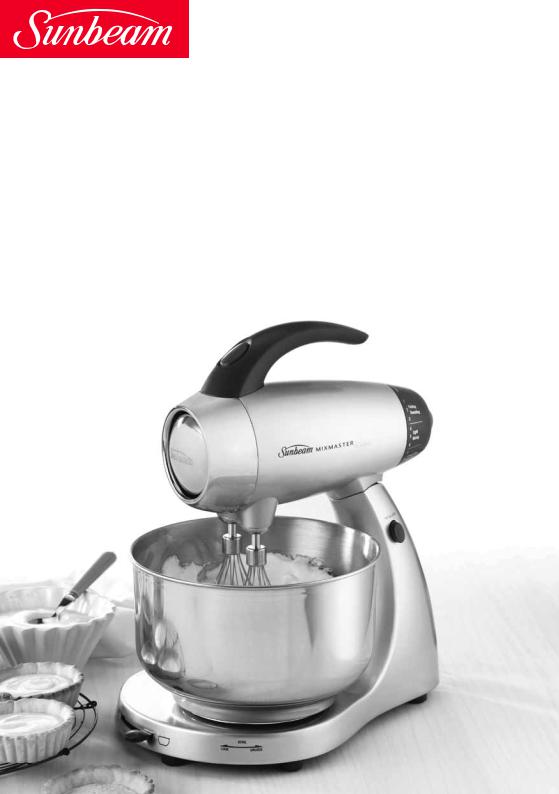
Mixmaster® Classic
Bench Mixer
Instruction Booklet
MX8500
MX8500W
MX8500Y
MX8500R
Please read these instructions carefully and retain for future reference.

Contents
Sunbeam’s Safety Precautions |
1 |
Features of your Mixmaster® Classic |
2 |
Using your Mixmaster® Classic |
4 |
Mixing guide |
8 |
Oven Temperature Guide |
9 |
Care and cleaning |
10 |
Lets talk ingredients |
11 |
Cookery tips for best results |
13 |
Helpful hints for a successful dough |
15 |
Recipes |
17 |
Important instructions – retain for future use.

Sunbeam’s Safety Precautions
SAFETY PRECAUTIONS FOR YOUR SUNBEAM MIXMASTER CLASSIC BENCH MIXER.
•Never eject beaters, whisks or dough hooks when the appliance is in operation.
•Ensure fingers are kept well away from moving beaters, whisks and dough hooks.
•Ensure that the bowl is secured and locked onto the base of the bench mixer before commencing mixing.
•Do not unlock or remove the mixing bowl from the base of the bench mixer whilst the mixer is in use.
•Should you be using a spatula during mixing, ensure that the spatula is kept well away from moving beaters, whisks and dough hooks.
•Never tilt back the head of the bench mixer whilst the appliance is in operation.
•When using extremely heavy loads the appliance should not be operated for more than 2 minutes. This does not apply to the recipes detailed in this booklet.
•Ensure long hair is tied back and young children are not near the moving bowl.
Sunbeam is very safety conscious when designing and manufacturing consumer products, but it is essential that the product user also exercise care when using an electrical appliance. Listed below are precautions which are essential for the safe use of an electrical appliance:
•Read carefully and save all the instructions provided with an appliance.
•Always turn the power off at the power outlet before you insert or remove a plug. Remove by grasping the plug - do not pull on the cord.
•Turn the power off and remove the plug when the appliance is not in use and before cleaning.
•Do not use your appliance with an extension cord unless this cord has been checked and tested by a qualified technician or service person.
•Always use your appliance from a power outlet of the voltage (A.C. only) marked on the appliance.
•This appliance is not intended for use by persons (including children) with reduced physical, sensory or mental capabilities, or lack of experience and knowledge, unless they have been given supervision or instruction concerning use of the appliance by a person responsible for their safety.
•Children should be supervised to ensure that they do not play with the appliance.
•The temperature of accessible surfaces may be high when the appliance is operating.
•Never leave an appliance unattended while in use.
•Do not use an appliance for any purpose other than its intended use.
•Do not place an appliance on or near a hot gas flame, electric element or on a heated oven.
•Do not place on top of any other appliance.
•Do not let the power cord of an appliance hang over the edge of a table or bench top or touch any hot surface.
•Do not operate any electrical appliance with a damaged cord or after the appliance has been damaged in any manner. If damage is suspected, return the appliance to the nearest Sunbeam Appointed Service Centre for examination, repair or adjustment.
•For additional protection, Sunbeam recommend the use of a residual current device (RCD) with a tripping current not exceeding 30mA in the electrical circuit supplying power to your appliances.
•Do not immerse the appliance in water or any other liquid unless recommended.
•Appliances are not intended to be operated by means of an external timer or separate remote control system.
•This appliance is intended to be used in household and similar applications such as: staff kitchen areas in shops, offices and other working environments; farm houses; by clients in hotels, motels and other residential type environments; bed and breakfast type environments.
If you have any concerns regarding the performance and use of your appliance, please visit www.sunbeam.com.au or contact the Sunbeam Consumer Service Line.
Ensure the above safety precautions are understood.
1
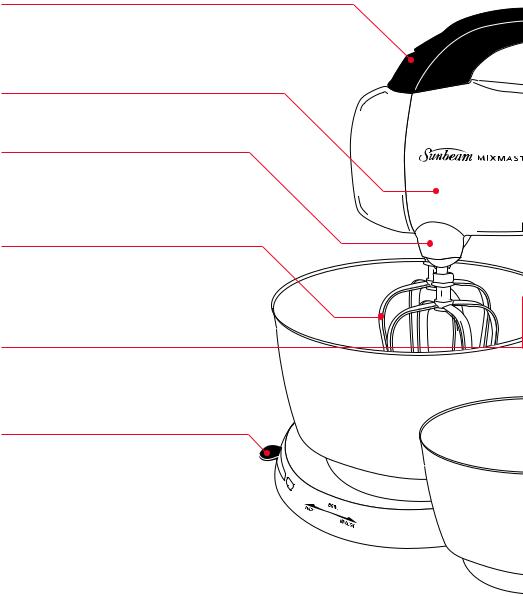
Features of your Mixmaster® Classic
Attachment eject button
The eject button, located on the top of the handle releases the beaters, whisks or dough hooks for easy cleaning.
500 watt motor
Powerful motor achieves thorough mixing results.
Off-centre head & beaters
The head of the bench mixer and beaters are positioned off-centre, making it easier to add ingredients during mixing.
3-way beating action
Sunbeam’s famous 3-way beating action allows the bowl and individual beaters to rotate in opposite directions for thorough mixing and better aeration.
Tilt back locking head
The head of the bench mixer tilts back and locks securely into position to allow easy removal of mixing bowls and attachments.
Bowl selector
Simply slide the bowl selector lever to the left when using the small bowl and to the right when using the large bowl.
2
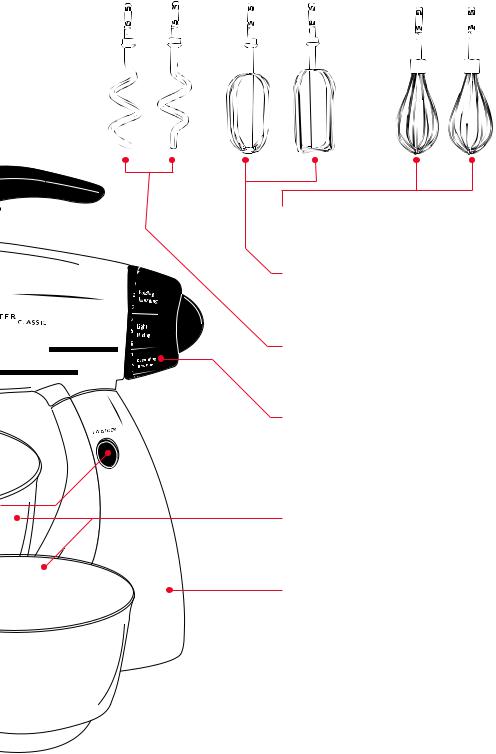
Stainless steel balloon whisks
For whisking light batters and packet cake mixes.
Stainless steel 'V-groove' beaters
Heavy duty 'V-groove' beaters for creaming butter and sugar, plus mixing heavy cake mixes.
Stainless steel dough hooks
Heavy duty dough hooks take the hard work out of kneading dough and other heavy mixtures.
12 electronic speeds
The combination of 12 variable speeds and a powerful torque control motor ensures superior mixing control and maintains speed regardless of the mixing load.
Stainless steel mixing bowls
4.2 and 2.1 litre mixing bowls are ideal for mixing large or small quantities of ingredients.
Die-cast metal body
The heavy duty die-cast metal body combined with non-slip rubber feet keep the bench mixer stable during operation.
3

Using your Mixmaster® Classic
Before using your bench mixer
Before using your bench mixer for the first time, remove any packaging material and promotional labels or tags. It is recommended to wash the mixing bowls, beaters, whisks and dough hooks in warm soapy water with a soft cloth. Rinse and dry thoroughly.
Set-up
Before assembling your bench mixer, be sure the power cord is unplugged from the power outlet and the speed control dial is in the 'Off' position. Position the bench mixer on a level, dry surface such as a bench top.
1.Press the 'TILT & LOCK' button, located on the neck of the bench mixer. While the button is depressed, hold the handle (Figure 1) and ease the head of the bench
mixer back. The bench mixer head will lock into this tilt position (Figure 2).
(1)



 TILT
TILT
BUTTON
2.Select the desired mixing attachments depending on the mixing task to be performed:
–Beaters for creaming butter and sugar, whisking cream or egg whites plus mixing heavy cake mixes.
–Whisks for light batters and packet cake mixes.
–Dough hooks for kneading dough and other heavy mixtures.
3.Insert selected attachment: |
|
Beaters – Take the beater that has |
|
a pointier, curved bottom and has |
A B |
a grey coloured band around the |
top of the beater – illustrated as beater
(A). Insert beater (A) into the left socket on the underside of the mixer head, the hole is identified by a grey dot beside it (Figure 3). Take the beater with the angular/flat bottom, illustrated as beater (B) and insert into the remaining socket.
Note: Be sure both beaters click firmly in place, you may need to twist the beater slightly to engage it in position prior to pushing it in place.
(3)
(2)
4
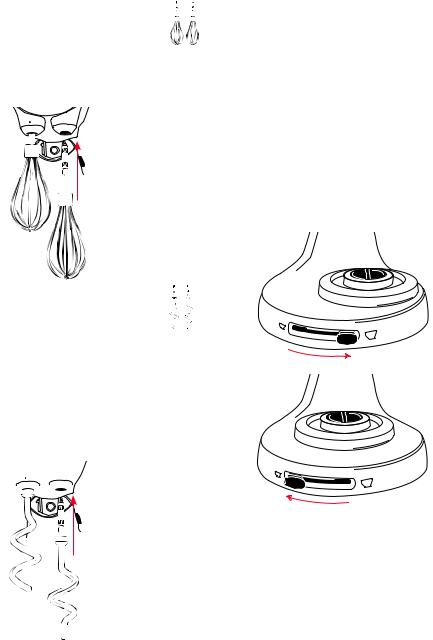
Using your Mixmaster® Classic continued
Balloon whisks – Can be inserted into either socket as they are identical (Figure 4).
Note: Be sure both whisks click A B firmly into place, you may need
to twist the whisk slightly to engage it in position prior to pushing it in place.
(4)
Dough hooks – Take the dough hook |
|
that is hooked at the bottom and |
|
has a grey coloured band around the |
A B |
top of the dough hook – illustrated |
|
as dough hook (A). Insert dough hook (A) into the left socket on the underside of the mixer head, the socket is identified by a grey dot beside it (Figure 5). Take the dough hook that is straight at the bottom, illustrated as dough hook (B) and insert into the remaining socket.
(5) 
Note: Be sure both dough hooks click firmly in place, you may need to twist the dough hook slightly to engage it in position prior to pushing it in place.
Important: These attachments have been designed with a safety feature so that they cannot be inserted in the incorrect way.
4.Depending on the amount of ingredients required for mixing, select the appropriate bowl size. If you have selected the large
4.2 litre bowl, slide the bowl selector to the far right (Figure 6a). If you have selected the smaller 2.1 litre bowl, slide
the bowl selector to the far left (Figure 6b).
(6a)
(6b)
5
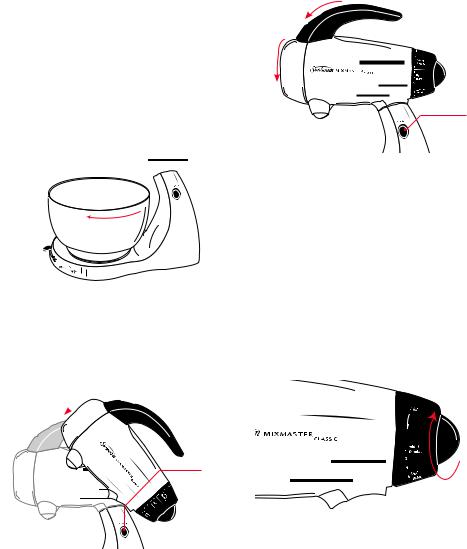
Using your Mixmaster® Classic continued
5.Once you have selected the bowl you wish to use, place it on the base. Gently rotate the bowl in a clockwise direction until it drops into position (Figure 7). Continue rotating until the bowl clicks into place. The bowl should feel firm.
Note: The mixer head must be tilted backwards for the bowl to be locked onto the turntable.
(7)

6.Lower the head with the selected mixing attachments in place into the mixing bowl. To do this press the 'TILT &LOCK' button. While the button is depressed hold the handle (Figure 8) and ease the head of the bench mixer down (Figure 9).
(8)
(9)
TILT
BUTTON
Using your Mixmaster® Bench Mixer
1.Position the mixer on a level, dry surface such as a bench top. Ensure the mixing bowl is in place and the desired attachments are inserted.
2.With the speed control dial in the 'Off' position, plug the power cord into a 230/240 Volt AC power outlet.
3.The speed control dial turns the bench mixer on and off, controlling the beater speed. Turn the speed control dial to the right or upwards to commence mixing (Figure 10).
(10)
TILT
BUTTON
Clearly marked instructions for correct mixing speeds for each type of mixture are shown in the 'Mixing Guide' on page 8.
6
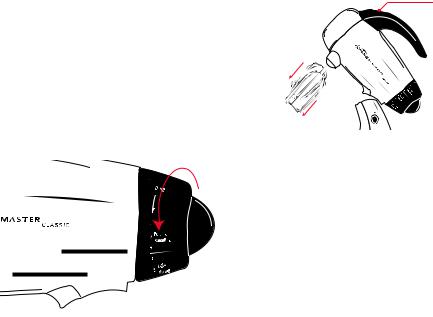
Using your Mixmaster® Classic continued
Tip: Start mixing at a slow speed and increase speed gradually to prevent ingredients splashing out of the mixing bowl. When adding dry ingredients, particularly flour, lower the speed temporarily until ingredients are combined.
Tip: When kneading yeast dough, use speed 1-5 to achieve best results. For more specific instructions for the use of the dough hooks see ‘Helpful hints for a successful dough' on page 15 of this booklet.
4.When mixing is complete, turn the speed control dial to the left or downwards, (Figure 11) until you have reached the 'Off' position and unplug the cord from the power outlet.
(11)
5.Hold down the 'TILT & LOCK' button and ease the head of the bench mixer back until the mixer head is locked into the tilt back position (see figures 1 and 2 on page 4).
6.To remove the attachments, place fingers loosely around the attachments and press the eject button located at the front of the handle (Figure 12).
(12)
EJECT
BUTTON
Rotation of Mixing Bowls
The mixing bowls are not rotated by a motor. The bowls are rotated by means of the tip of the attachment (beater and whisk) making contact with the bowl and the mixture passing ingredients through the attachments.
Note: The consistency of some mixtures may prevent the bowl from rotating. In this case you may choose to give the bowl a gentle turn to ensure thorough mixing.
When the dough hooks are inserted, the bowl is rotated by the ingredients passing through the dough hooks as they turn.
Note: Prior to the ingredients starting to combine, the bowl may require a gentle turn to assist in the rotation of the bowl.
7

Mixing guide
Please keep in mind that the various mixing tasks and related speeds, listed in the table below, may vary slightly from recipe to recipe.
Please refer to it regularly as you develop your understanding of how different ingredients interact when mixing.
SPEED SETTING RANGE |
MIXING TASK |
|
LOW |
FOLDING & KNEADING |
|
Folding |
||
1-3 |
||
Kneading – doughs (pastry, bread, scones) |
||
|
|
LIGHT MIXING |
MEDIUM |
Kneading - heavy doughs (large quantities) |
4-6 |
Beating – packet mixes |
|
Beating – creaming sugar and butter |
HIGH |
BEATING |
|
Whisking – light batters |
||
7-9 |
||
Beating – cake mixes/heavy batters/icings |
||
|
VERY HIGH |
WHIPPING & AERATING |
10-12 |
Whisking – egg whites/cream |
NOTES:
For most recipes, it is better to begin your mixing on a slower speed until the ingredients begin combining, then move to
the appropriate speed range for the particular task.
Generally there is no one set speed for an entire recipe. You will need to change the speed of the bench mixer depending on what
stage of the recipe you are working on. This is communicated in the recipe section.
When mixing larger quantities you may need to increase the bench mixer speed due to the amount of mixing required and the larger load on the machine.
When building up a recipe that requires the addition of dry ingredients, such as flour, slow the speed down whilst these ingredients are being added to avoid a snow storm effect.
Once the extra ingredients begin combining then slowly increase to the appropriate speed for the particular mixing task.
8
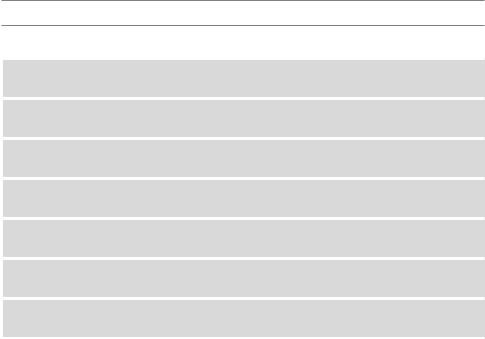
Oven Temperature Guide
For your information, the following temperature settings are included as a guide.
Thermostat Settings
DESCRIPTION OF |
Degrees Celcius °C |
Degrees Farenheit °F |
Gas Mark |
|
OVEN TEMPERATURES |
||||
|
|
|
||
Very Slow |
120 |
250 |
½ |
|
Slow |
140-150 |
300 |
1-2 |
|
Moderately Slow |
160 |
325 |
3 |
|
Moderate |
180 |
350 |
4 |
|
Moderately hot |
200 |
400 |
6 |
|
Hot |
220 |
425 |
8 |
|
Very Hot |
240 |
475 |
9 |
Note: If using fan forced ovens be sure to turn the temperature down by 20°C. Also check recipes at the back of this booklet.
9
